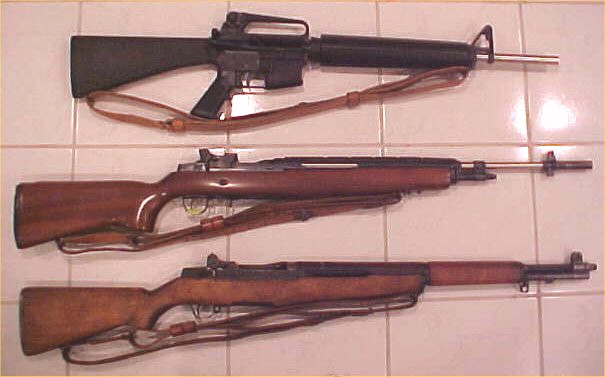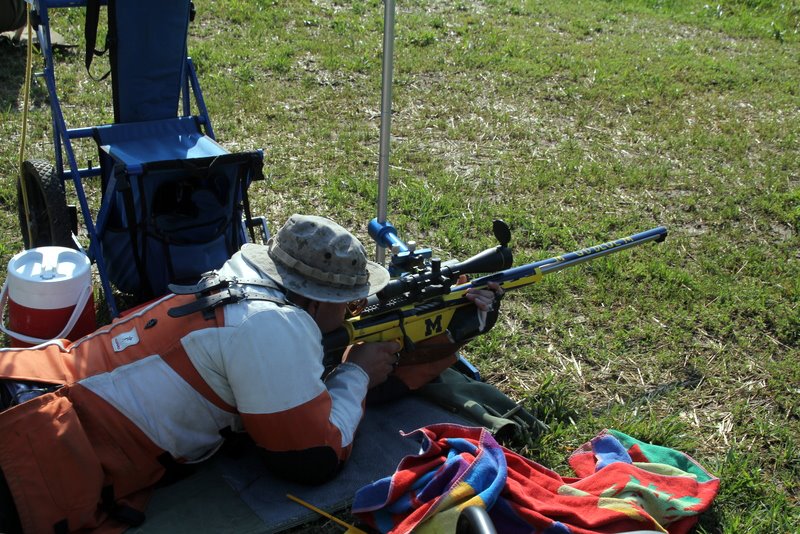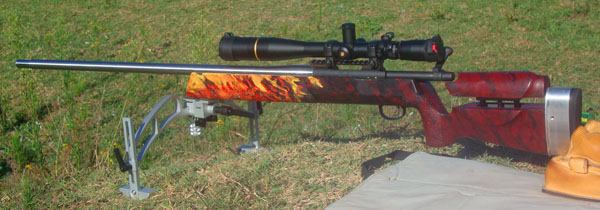Long Range prone and F-Class
Unlimted sighters* and 20 rounds for record (Iron Sights)
NRA Long Range matches are shot at 800 to 1000 yards. There will be a 2 shooter block time of 50 minutes for prep, sighters and record shots.
The course of fire can be as follows
3x1000 (yards): Three 20 shot matches (plus sighters) at 1000 yards
Unlimited sighters and 20 rounds for record (Any Sight)
2 convertible sighters and 20 rounds for record (Any Sight)
Unlimted sighters* and 20 rounds for record (Iron Sights)
*F class will have 2 convertible sighters for their third match
2x1000 (yards): Two 20 shot matches (plus sighters) at 1000 yards
Unlimited sighters and 20 rounds for record (Any Sight)Unlimted sighters* and 20 rounds for record (Iron Sights)
* F class will have 2 convertible sighters for their second match
"Palma Course": 15 shots (plus sighters) at each of 800, 900, and 1000 yards
800 yards- unlimited sighters, 15 shots for record in a time period of 25 minutes
900 yards- 2 convertible sighters, 15 shots for record in a time period of 22 minutes
1000 yards- 2 convertible sighters, 15 shots for record in a time period of 22 minutes
1000 yard Slow Prone
1000 yard Slow Prone Wimbledon Cup
Palma Course
Traditionally a Palma match is limited to .308 or .223 caliber rifles and is shot at 800,900, and 1000 yards with metallic sights, and some additional restrictions. However not everybody owns a Palma rifle: CIHPRS' Palma Matches will be open to all of the traditional classes of rifles and F-Class.
800 yards- unlimited sighters, 15 shots for record in a time period of 25 minutes
900 yards- 2 convertible sighters, 15 shots for record in a time period of 22 minutes
1000 yards- 2 convertible sighters, 15 shots for record in a time period of 22 minutes
800 yard stage
The following rifle categories are used in Long Range matches
Service Rifle
US Rifle, Caliber .30 M1, or Caliber 7.62mm M1
US Rifle, Caliber 7.62mm M14
US Rifle, Caliber 5.56mm M16 Series
US Rifle, Caliber 7.62mm M110 Series
Rifles must have standard or National Match type sights however the AR-15 may have a 4.5x optical sight. It must have a trigger pound equal to or greater than 4.5 pounds. There are also other rifle specific requirements for each of the above. Please check NRA rule 3.1

Starting in 2016 AR-15 Service rifles were allowed to have a scope with a maximum magnification of 4.5x. In 2018 this was opened up to all service rifles.
Service Rifle (Unofficial)
Any rifle that was once a service rifle but is no longer considered a service rifle by the NRA or CMP or of a foreign government. The rifle must have peep and post sights or V-notch and post sights and be in original as issued condition. The rifle must be .35 caliber and under and must use smokeless powder.
This class will compete in Service rifle division in CIHPRS club matches only.
The rifles will include but not limited to:
Remington Lee 6mm
Springfield Model 1892-1899 Krag
US Model 1903, 1903A1, 1903A3, and National Match rifles (no micrometer sights)
US Model 1917
US Model 1941 Johnson
Foreign Government rifles manual or semi-automatic are eligible regardless of model provided they are of peep and post sight or v-notch and post sight configuration and are under .35 caliber and use smokeless powder.
Any Rifle
A centerfire rifle with no restrictions on sights or accessories, accept no muzzle breakes or silensors. Rifles must be .35 caliber or less. Metallic or Optical sights may be used depending on the match format. NRA Rule 3.2


Palma Rifle
A rifle chambered for the unmodified .308/7.62mm, or .223/5.56mm NATO cartridges with metallic sights. NRA Rule 3.3.1

F-Open Rifle
A centerfire rifle with a caliber limit of .35 and under. A weight limit of 22lbs. or less. A stock forearm of 3 inches or less. The shooter is allowed to use an adjustable front rest and rear bag. Optical or Metallic sights are permitted. NRA Rule 3.4a and 3.4.1a

1000 yard F-Class
F-T/R
A rifle chambered for the unmodified .308/7.62mm, or .223/5.56mm NATO cartridges with a weight limit of 18.18lbs. The shooter is allowed to use a sling and/or bipod along with a rear bag. Optical or Metallic sights are permitted. NRA Rule 3.4b and 3.4.1b

F-Practical
A rifle chambered in any cartridge with a weight limit of 18.18lbs. The Shooter is allowed to use a bipod of a Harris style and a non bunny ear rear bag.
Needed equipment:
Rifle capable of shooting the required distances (see below)
Rests if shooting F class
Spotting scope
Eye and hearing protection
Recommended equipment for sling shooters
Shooting Coat
Shooting Glove
Shooting Mat
Will my rifle work at 1000 yards?
There are no hard set answers as what will and what won't work however there are some general criteria we can follow.
First criteria if your rifle or ammo meets any of the following the answer is generally, no it will not work
- Using hunting or Varmint bullets, don't try it only use match bullets
- A rifle with barrel length shorter than 20 inches. Standard loads will not be able to get the needed velocity and if a load can it probably is not safe to shoot.
- A .22 caliber rifle with a twist slower than 1:8. Your rifle will not be able to stabilize the heavier bullets. Some factory 6mm's and 6.5mm's will have twists that are to slow. For a 6mm such as a .243 Win a twist of 1:8.5 or faster is recommended. For a 6.5mm such as a .260 Remington a twist of 1:9 or faster is recommended.
- Shooting 168gr Sierra Match Kings or Nosler Custom Competition bullets. This is due to the angle of the boat tail design which causes the bullets to tumble as they go transonic. Other 168's will work since they have a different bullet design.
- An AR-15 can get to 1000 yds. but you need to push the bullet really hard and it is not recommended for the beginning shooter.
Second criteria we need to make sure we have a bullet that has a high enough ballistic coefficient to get there ok. Bellow are some following criteria.
.22cal- If you must, any match bullet 80gr or higher.
6mm- Any match bullet 105gr or heavier
6.5mm- There are a lot of choices that will work. The 130gr Berger VLD is probably as light as you want to go with the Lapua 136gr and the bulelts in the 139-142gr range being better choices.
7mm- Any match bullet 168gr or heavier
.30cal- Any match bullet 155gr or heavier (excluding the 168gr SMK and Nosler Custom Comp). However special note the 155's need to be pushed fast mentioned below
Ok so now we have a bullet selected, for the third criteria we need to make sure our cartridge can push it fast enough. But before we talk numbers let me say, speed does not mean better. It is where your gun shoots the best. Just because someone claims to have some 6.5mm ultra super cartridge that can sling 142's down range at 3,200fps doesn't mean his is better. DO NOT get caught up playing the speed game.
| Bullet | Velocity |
| .22cal 80gr SMK | 3,000 fps |
| 6mm 107gr SMK | 2,850 fps |
| 6.5mm 142gr SMK | 2,620 fps |
| 7mm 175gr SMK | 2,580 fps |
| .30cal 155gr SMK | 2,950 fps |
| .30cal 175gr SMK | 2,580 fps |
The above are just general guidelines that if your rifle/cartridge combination can get there you will keep the bullet above Mach 1.1 or higher.
Ok fourth and final criteria we need to make sure our sights have enough elevation. If we use the above velocities you will need the following elevations from a 100yd zero
| Bullet | Velocity |
| .22cal 80gr SMK | 33 MOA |
| 6mm 107gr SMK | 30 MOA |
| 6.5mm 142gr SMK | 34 MOA |
| 7mm 175gr SMK | 33 MOA |
| .30cal 155gr SMK | 34 MOA |
| .30cal 175gr SMK | 42 MOA |
If your rifle can meet all these criteria then you "should" be able to reliably make it to the 1000yd target. There are a lot of cartridges and bullets out there. If you want more specifics as to what works best talk to experienced shooters at the match. If you want to know why stuff works read the following book written by Bryan Litz, Applied Ballistics for Long Range Shooting.



